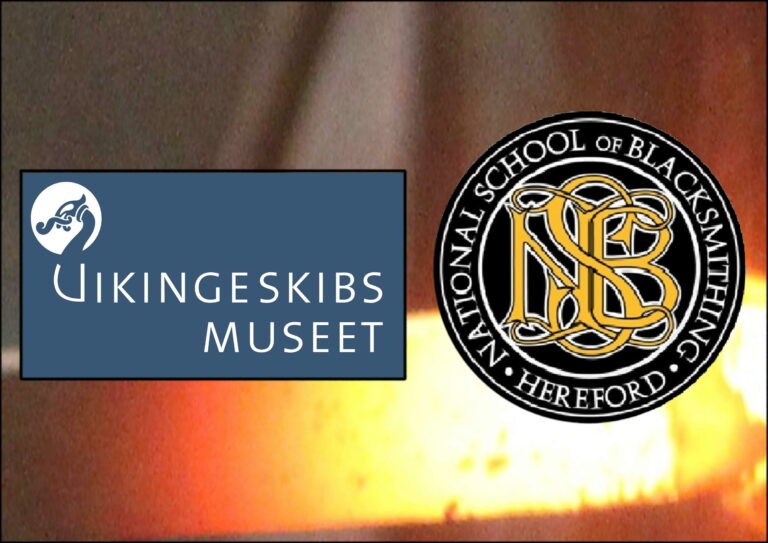About the trip
From the 23rd to the 30th of May 2024. 11 Level-3 students from the National School of Blacksmithing, Holme Lacy College, will travel to Denmark. Accompanied by their tutors, they are heading to visit the Viking Ship Museum in Roskilde – around 30 minutes West of Copenhagen.
The Viking Ship Museum holds a collection of around 40 vessels, including the remains of several Viking boats on display. However, the main attraction for the blacksmithing students is the attached shipyard. This is where fully researched, full-scale Viking craft are built from scratch. The timber is felled locally, and hand-hewn into strakes, stems, ribs, etc. Also at the shipyard, wool is woven into sails, and hemp and bast turned into cordage. The vessels produced at the yard are sailed by volunteers or disseminated to other museums. The museum has an international reputation as a centre of excellence for practical research into Viking seafaring and shipbuilding technologies.
What will the students be doing?
Students will be split into four teams. They will forge a full-scale replica of the Ladby anchor, a type-2 Viking-age anchor, alongside 12 metres of chain. The anchor itself stands at 126 cm tall by 84 cm wide and will weigh around 32kg. The anchor will be made from wrought iron and in four separate components. Once completed, the four components will be forge-welded together by the students.
Excitingly, the anchor and chain are destined to be used on the ship currently under construction at the museum: A replica of the Skuldelev 5 vessel – a 17.3m long warship, dating from ca. 1030 AD.
The manufacturing process will be accompanied by explanations for the interpretation of the evidence (X-radiography, XRF analysis, metallography, photography, etc) which has guided the design from which they are working. For some of the students, the visit builds on Unit 23, archaeological reconstruction work, which sees students reverse-engineer an archaeological or historical object before reproducing it like-for-like.
If the anchor and chain are completed ahead of schedule, the students will be able to forge tooling for the shipwrights, display items for the museum and other replica iron components for the ships and the museum.
About the staff
Blacksmithing teaching staff, and organisers of the Denmark Anchor Project, Rowan Taylor and Mischa Kunkel, have experience of historical ironwork. Rowan has been a conservation smith since 2013. He has worked on conservation projects at Hampton Court Palace, the Imperial War Museum, Pontcysyllte aqueduct, Beeston iron lock, etc. Since 2021 he has been teaching the final year of the Level 3 course at the National School of Blacksmithing, Hereford whilst running a private business reverse-engineering and documenting historical and archaeological objects.
Mischa Kunkel has been teaching the L2 course at the National School of blacksmithing since 2017. Prior to this she was in private practice. Mischa has a keen interest in historical techniques and practices and a passion for archaeological ironwork. She has been a key participant in the design and planning of this project. Part of their interest in delivering this visit was to combine their love of teaching with their passion for historical practices and techniques pertaining to ironwork.
What will be gained?
The trip itself will provide an incredible enrichment opportunity for the students with regards to archaeometallurgy, historical forging processes and iron production as well as large-scale forging techniques and working as teams. Students will not only benefit from the knowledge and learning involved in forging and assembling a large, multi-component object as a team. They will also gain enrichment provided by the proximity of the shipwrights, ropemakers and sailmakers with whom they will be able to work once the main project is finished and from their
exposure to traditional skills and techniques. They will also be able to put in their CVs and portfolios that they participated in the recreation of a 1,200-year-old anchor for a replica of an 1,100 year old ship.
The project has also garnered the imagination of other staff and students. Welding apprentices are currently making the four portable forges, which will be sent to the Viking Ship Museum for the Level 3 blacksmiths to use. The portable forges were designed by Henry Pomfret, who teaches the BA blacksmithing students and are being made by the apprentices under the careful direction of Joshua Massey, technician, and Kamil Mizinsky, welding tutor.
We hope that this will become a yearly trip for final-year blacksmithing students at Holme Lacy.
Viking Ship Museum Social Media
National School of Blacksmithing Social Media
Photos: Werner Karrasch. Copyright: Viking Ship Museum in Roskilde.










